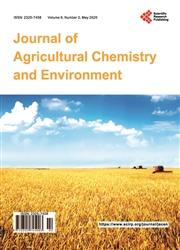Spatial Availability of Nitrogen and Pesticides in the Surface Layers of Agricultural Soils of Tropical Hydrosystems in the Wet Season: Case of the Béré Watershed in Côte d’Ivoire (West Africa)
引用次数: 0
Abstract
The objective of this study was to assess the contribution of the spatial organization of cropping systems and the physicochemical properties of surface layers of the agricultural zones soils in tropical hydrosystems to the spatial availability of nitrogen and pesticides during the wet season, such as the Bere watershed (BW) in Cote d’Ivoire. For this purpose, after mapping the spatial distribution of the BW cropping systems based on the likelihood classification methodology of satellite images of the study area, 27 samples from the 0 - 20 cm horizon of the soil surface layers of the agricultural areas were taken during the wet and agricultural season of the year 2016. The Kjeldahl method has been used to evaluate the total nitrogen concentration and high-performance liquid chromatography (HPLC) chain made it possible for the analysis of pesticide residues in the soil solutions. Geostatistical analysis and processing of spatial data and physicochemical and agrochemical soil parameters revealed that two major agricultural areas stand out in the BW, namely the Bere upstream watershed (BUW) dominated at 32.65% by annual croppings (maize, cotton, rainfed or lowland rice, market gardening, etc.) and the Bere downstream watershed (BDW) by large areas of perennial croppings (cashew nuts, cocoa, etc.), i.e. 21.47%. Agricultural soils in BW are usually of the moderately desaturated ferralitic type with a low acid pH and a quite strong temperature, such as those of tropical soils’ characteristics. However, agricultural soils in the BUW are characterized by higher proportions of sand and coarse sand. The parameters such as total porosity, cation exchange capacity, clay, organic matter, silt, fine silt, coarse silt, and potassium ions, are higher in the soils of the agricultural area of the BDW. Moreover, soils in the agricultural areas of the BUW are less rich in total nitrogen (0.84 g·kg-1) in contrast to those of the BDW (1.2 g·kg-1). On the other hand, the median concentrations of total pesticides remain very high in the BUW (193.80 μg·kg-1) in front of those of the BDW (94.81 μg·kg-1). In addition, the biological family of herbicides was the most notable in BW. The chemical families of triazines (100% detection; 79.37 μg·kg-1) are the most important in the agricultural area of the BUW with the very significant presence of active molecules of pesticides such as simazine (92.86% detection; 13.17 μg·kg-1). However, in the BDW, urea substitute (100% detection; 44.02 μg·kg-1) dominate, including the active substance chlortoluron (84.62% detection; 10.12 μg·kg-1). The presence and abundance of nitrogen and pesticides in the soils of the agricultural areas of BW are strongly linked to the intensive use of these agrochemicals in cropping systems in recent decades in West African countries, even though most of the active molecules found are forbidden in several countries, especially in European countries. These are applied to tropical agricultural soils with physicochemical characteristics favorable to their retention in wet weather, as confirmed by the case of BW’s agricultural soils. Therefore, the BW’s water resources present worrying risks of contamination during rainy events that deserve to be assessed and monitored. Hence the need to take mitigating measures to this effect in order to preserve the quality of the environment.雨季热带水系农业土壤表层氮和农药的空间有效性——以Côte科特迪瓦b r流域为例
本研究的目的是评估热带水系统中种植系统的空间组织和农业区土壤表层的物理化学性质对雨季氮和农药空间可用性的贡献,如科特迪瓦的贝雷流域。为此,在根据研究区域卫星图像的可能性分类方法绘制BW种植系统的空间分布图后,在2016年的雨季和农业季节,从农业区域土壤表层0-20厘米的地平线上采集了27个样本。凯氏定氮法已被用于评估总氮浓度,高效液相色谱(HPLC)链使分析土壤溶液中的农药残留成为可能。对空间数据、理化和农用化学土壤参数的地统计学分析和处理表明,两个主要农业区在BW中脱颖而出,即贝雷上游流域(BUW)以32.65%的年产量(玉米、棉花、雨养或低地水稻、市场园艺等)为主,贝雷下游流域(BDW)以大面积的多年生作物(腰果、可可等)为主(21.47%),例如热带土壤的特征。然而,BUW的农业土壤的特点是沙子和粗砂比例较高。BDW农业区土壤的总孔隙度、阳离子交换能力、粘土、有机质、淤泥、细淤泥、粗淤泥和钾离子等参数较高。此外,BUW农业区的土壤总氮含量较低(0.84 g·kg-1),而BDW农业区土壤总氮浓度较低(1.2 g·kg-1)。另一方面,BUW中总农药的中位浓度(193.80μg·kg-1)仍然很高,高于BDW(94.81μg·kg-1)。此外,除草剂的生物家族在BW中最为显著。三嗪类化合物的化学家族(100%检测;79.37μg·kg-1)在BUW的农业区是最重要的,其中存在非常显著的农药活性分子,如西马嗪(92.86%检测;13.17μg·kg-1)。然而,在BDW中,尿素替代物(100%检测;44.02μg·kg-1)占主导地位,包括活性物质绿麦隆(84.62%检测;10.12μg·kg-1)。BW农业区土壤中氮和农药的存在和丰度与近几十年来西非国家在种植系统中大量使用这些农用化学品密切相关,尽管在一些国家,特别是欧洲国家,发现的大多数活性分子都是被禁止的。这些应用于具有物理化学特性的热带农业土壤,有利于其在潮湿天气中的保持,BW的农业土壤的情况证实了这一点。因此,BW的水资源在雨季存在令人担忧的污染风险,值得评估和监测。因此,有必要为此采取缓解措施,以保护环境质量。
本文章由计算机程序翻译,如有差异,请以英文原文为准。
求助全文
约1分钟内获得全文
求助全文

 求助内容:
求助内容: 应助结果提醒方式:
应助结果提醒方式:


